Richong Zhang
Improving Subgraph Matching by Combining Algorithms and Graph Neural Networks
Jul 27, 2025Abstract:Homomorphism is a key mapping technique between graphs that preserves their structure. Given a graph and a pattern, the subgraph homomorphism problem involves finding a mapping from the pattern to the graph, ensuring that adjacent vertices in the pattern are mapped to adjacent vertices in the graph. Unlike subgraph isomorphism, which requires a one-to-one mapping, homomorphism allows multiple vertices in the pattern to map to the same vertex in the graph, making it more complex. We propose HFrame, the first graph neural network-based framework for subgraph homomorphism, which integrates traditional algorithms with machine learning techniques. We demonstrate that HFrame outperforms standard graph neural networks by being able to distinguish more graph pairs where the pattern is not homomorphic to the graph. Additionally, we provide a generalization error bound for HFrame. Through experiments on both real-world and synthetic graphs, we show that HFrame is up to 101.91 times faster than exact matching algorithms and achieves an average accuracy of 0.962.
General Table Question Answering via Answer-Formula Joint Generation
Mar 16, 2025Abstract:Advanced table question answering (TableQA) methods prompt large language models (LLMs) to generate answer text, SQL query, Python code, or custom operations, which impressively improve the complex reasoning problems in the TableQA task. However, these methods lack the versatility to cope with specific question types or table structures. In contrast, the Spreadsheet Formula, the widely-used and well-defined operation language for tabular data, has not been thoroughly explored to solve TableQA. In this paper, we first attempt to use Formula as the logical form for solving complex reasoning on the tables with different structures. Specifically, we construct a large Formula-annotated TableQA dataset \texttt{FromulaQA} from existing datasets. In addition, we propose \texttt{TabAF}, a general table answering framework to solve multiple types of tasks over multiple types of tables simultaneously. Unlike existing methods, \texttt{TabAF} decodes answers and Formulas with a single LLM backbone, demonstrating great versatility and generalization. \texttt{TabAF} based on Llama3.1-70B achieves new state-of-the-art performance on the WikiTableQuestion, HiTab and TabFact.
Lost-in-the-Middle in Long-Text Generation: Synthetic Dataset, Evaluation Framework, and Mitigation
Mar 10, 2025Abstract:Existing long-text generation methods primarily concentrate on producing lengthy texts from short inputs, neglecting the long-input and long-output tasks. Such tasks have numerous practical applications while lacking available benchmarks. Moreover, as the input grows in length, existing methods inevitably encounter the "lost-in-the-middle" phenomenon. In this paper, we first introduce a Long Input and Output Benchmark (LongInOutBench), including a synthetic dataset and a comprehensive evaluation framework, addressing the challenge of the missing benchmark. We then develop the Retrieval-Augmented Long-Text Writer (RAL-Writer), which retrieves and restates important yet overlooked content, mitigating the "lost-in-the-middle" issue by constructing explicit prompts. We finally employ the proposed LongInOutBench to evaluate our RAL-Writer against comparable baselines, and the results demonstrate the effectiveness of our approach. Our code has been released at https://github.com/OnlyAR/RAL-Writer.
A Graph-based Verification Framework for Fact-Checking
Mar 10, 2025Abstract:Fact-checking plays a crucial role in combating misinformation. Existing methods using large language models (LLMs) for claim decomposition face two key limitations: (1) insufficient decomposition, introducing unnecessary complexity to the verification process, and (2) ambiguity of mentions, leading to incorrect verification results. To address these challenges, we suggest introducing a claim graph consisting of triplets to address the insufficient decomposition problem and reduce mention ambiguity through graph structure. Based on this core idea, we propose a graph-based framework, GraphFC, for fact-checking. The framework features three key components: graph construction, which builds both claim and evidence graphs; graph-guided planning, which prioritizes the triplet verification order; and graph-guided checking, which verifies the triples one by one between claim and evidence graphs. Extensive experiments show that GraphFC enables fine-grained decomposition while resolving referential ambiguities through relational constraints, achieving state-of-the-art performance across three datasets.
Implicit Word Reordering with Knowledge Distillation for Cross-Lingual Dependency Parsing
Feb 24, 2025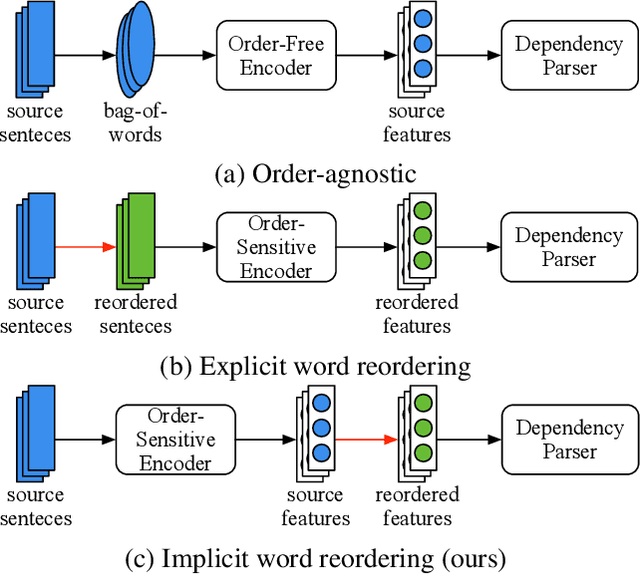

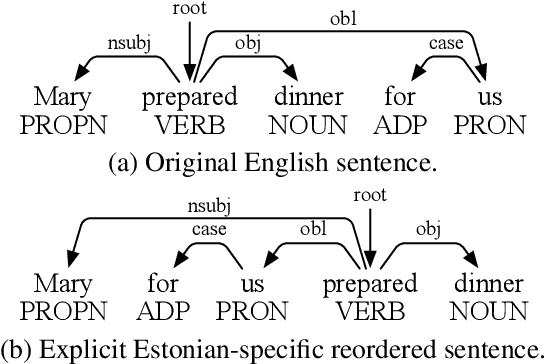

Abstract:Word order difference between source and target languages is a major obstacle to cross-lingual transfer, especially in the dependency parsing task. Current works are mostly based on order-agnostic models or word reordering to mitigate this problem. However, such methods either do not leverage grammatical information naturally contained in word order or are computationally expensive as the permutation space grows exponentially with the sentence length. Moreover, the reordered source sentence with an unnatural word order may be a form of noising that harms the model learning. To this end, we propose an Implicit Word Reordering framework with Knowledge Distillation (IWR-KD). This framework is inspired by that deep networks are good at learning feature linearization corresponding to meaningful data transformation, e.g. word reordering. To realize this idea, we introduce a knowledge distillation framework composed of a word-reordering teacher model and a dependency parsing student model. We verify our proposed method on Universal Dependency Treebanks across 31 different languages and show it outperforms a series of competitors, together with experimental analysis to illustrate how our method works towards training a robust parser.
XRAG: eXamining the Core -- Benchmarking Foundational Components in Advanced Retrieval-Augmented Generation
Dec 24, 2024Abstract:Retrieval-augmented generation (RAG) synergizes the retrieval of pertinent data with the generative capabilities of Large Language Models (LLMs), ensuring that the generated output is not only contextually relevant but also accurate and current. We introduce XRAG, an open-source, modular codebase that facilitates exhaustive evaluation of the performance of foundational components of advanced RAG modules. These components are systematically categorized into four core phases: pre-retrieval, retrieval, post-retrieval, and generation. We systematically analyse them across reconfigured datasets, providing a comprehensive benchmark for their effectiveness. As the complexity of RAG systems continues to escalate, we underscore the critical need to identify potential failure points in RAG systems. We formulate a suite of experimental methodologies and diagnostic testing protocols to dissect the failure points inherent in RAG engineering. Subsequently, we proffer bespoke solutions aimed at bolstering the overall performance of these modules. Our work thoroughly evaluates the performance of advanced core components in RAG systems, providing insights into optimizations for prevalent failure points.
LH-Mix: Local Hierarchy Correlation Guided Mixup over Hierarchical Prompt Tuning
Dec 22, 2024Abstract:Hierarchical text classification (HTC) aims to assign one or more labels in the hierarchy for each text. Many methods represent this structure as a global hierarchy, leading to redundant graph structures. To address this, incorporating a text-specific local hierarchy is essential. However, existing approaches often model this local hierarchy as a sequence, focusing on explicit parent-child relationships while ignoring implicit correlations among sibling/peer relationships. In this paper, we first integrate local hierarchies into a manual depth-level prompt to capture parent-child relationships. We then apply Mixup to this hierarchical prompt tuning scheme to improve the latent correlation within sibling/peer relationships. Notably, we propose a novel Mixup ratio guided by local hierarchy correlation to effectively capture intrinsic correlations. This Local Hierarchy Mixup (LH-Mix) model demonstrates remarkable performance across three widely-used datasets.
Rethink the Evaluation Protocol of Model Merging on Classification Task
Dec 18, 2024



Abstract:Model merging combines multiple fine-tuned models into a single one via parameter fusion, achieving improvements across many tasks. However, in the classification task, we find a misalignment issue between merging outputs and the fine-tuned classifier, which limits its effectiveness. In this paper, we demonstrate the following observations: (1) The embedding quality of the merging outputs is already very high, and the primary reason for the differences in classification performance lies in the misalignment issue. (2) We propose FT-Classifier, a new protocol that fine-tunes an aligned classifier with few-shot samples to alleviate misalignment, enabling better evaluation of merging outputs and improved classification performance. (3) The misalignment is relatively straightforward and can be formulated as an orthogonal transformation. Experiments demonstrate the existence of misalignment and the effectiveness of our FT-Classifier evaluation protocol.
When Text Embedding Meets Large Language Model: A Comprehensive Survey
Dec 12, 2024



Abstract:Text embedding has become a foundational technology in natural language processing (NLP) during the deep learning era, driving advancements across a wide array of downstream tasks. While many natural language understanding challenges can now be modeled using generative paradigms and leverage the robust generative and comprehension capabilities of large language models (LLMs), numerous practical applications, such as semantic matching, clustering, and information retrieval, continue to rely on text embeddings for their efficiency and effectiveness. In this survey, we categorize the interplay between LLMs and text embeddings into three overarching themes: (1) LLM-augmented text embedding, enhancing traditional embedding methods with LLMs; (2) LLMs as text embedders, utilizing their innate capabilities for embedding generation; and (3) Text embedding understanding with LLMs, leveraging LLMs to analyze and interpret embeddings. By organizing these efforts based on interaction patterns rather than specific downstream applications, we offer a novel and systematic overview of contributions from various research and application domains in the era of LLMs. Furthermore, we highlight the unresolved challenges that persisted in the pre-LLM era with pre-trained language models (PLMs) and explore the emerging obstacles brought forth by LLMs. Building on this analysis, we outline prospective directions for the evolution of text embedding, addressing both theoretical and practical opportunities in the rapidly advancing landscape of NLP.
MMGenBench: Evaluating the Limits of LMMs from the Text-to-Image Generation Perspective
Nov 21, 2024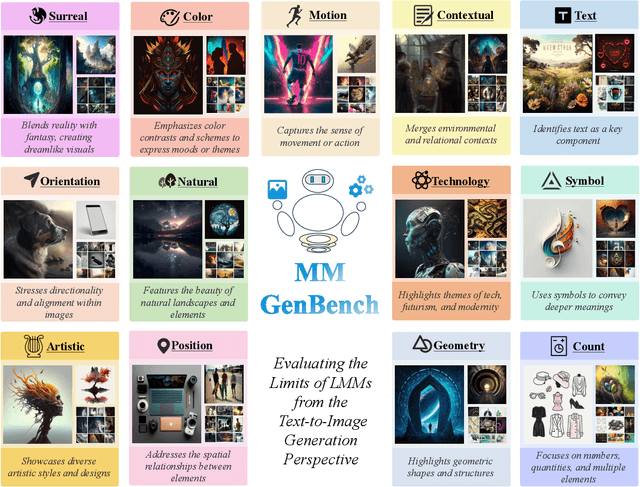
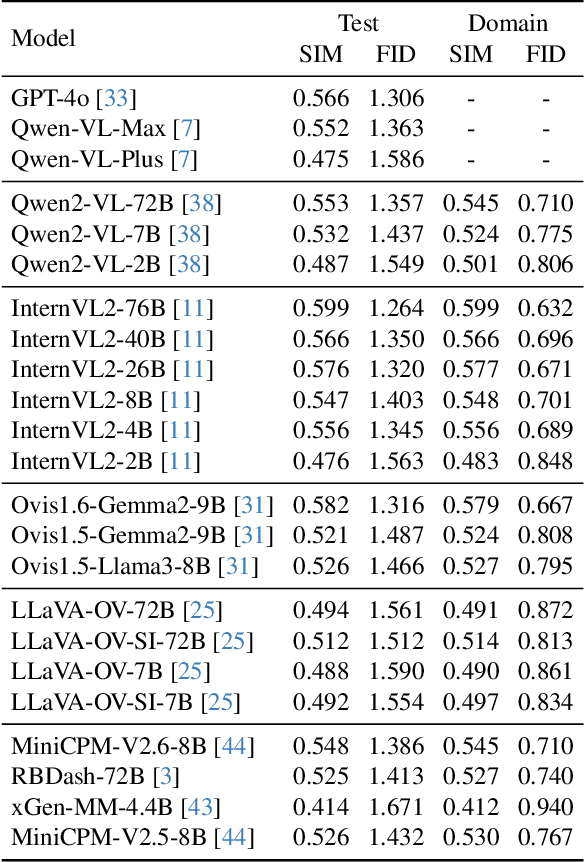
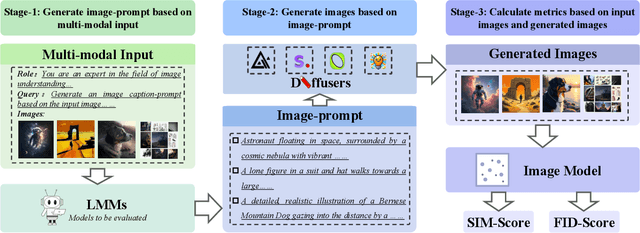
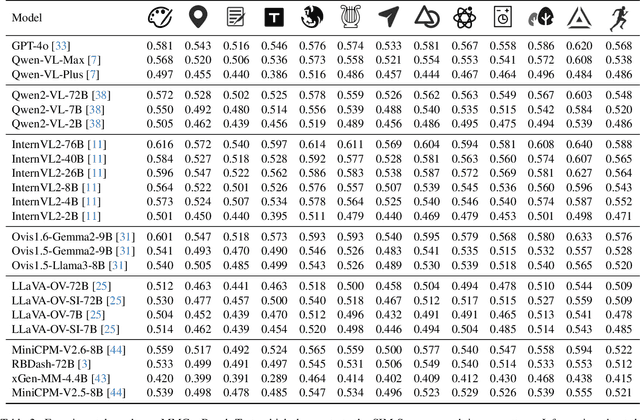
Abstract:Large Multimodal Models (LMMs) have demonstrated remarkable capabilities. While existing benchmarks for evaluating LMMs mainly focus on image comprehension, few works evaluate them from the image generation perspective. To address this issue, we propose a straightforward automated evaluation pipeline. Specifically, this pipeline requires LMMs to generate an image-prompt from a given input image. Subsequently, it employs text-to-image generative models to create a new image based on these generated prompts. Finally, we evaluate the performance of LMMs by comparing the original image with the generated one. Furthermore, we introduce MMGenBench-Test, a comprehensive benchmark developed to evaluate LMMs across 13 distinct image patterns, and MMGenBench-Domain, targeting the performance evaluation of LMMs within the generative image domain. A thorough evaluation involving over 50 popular LMMs demonstrates the effectiveness and reliability in both the pipeline and benchmark. Our observations indicate that numerous LMMs excelling in existing benchmarks fail to adequately complete the basic tasks, related to image understanding and description. This finding highlights the substantial potential for performance improvement in current LMMs and suggests avenues for future model optimization. Concurrently, our pipeline facilitates the efficient assessment of LMMs performance across diverse domains by using solely image inputs.
 Add to Chrome
Add to Chrome Add to Firefox
Add to Firefox Add to Edge
Add to Edge